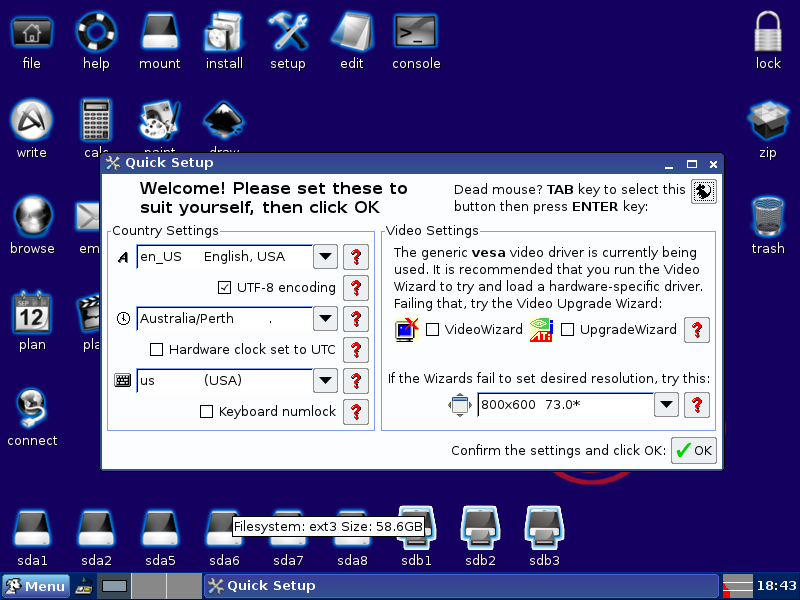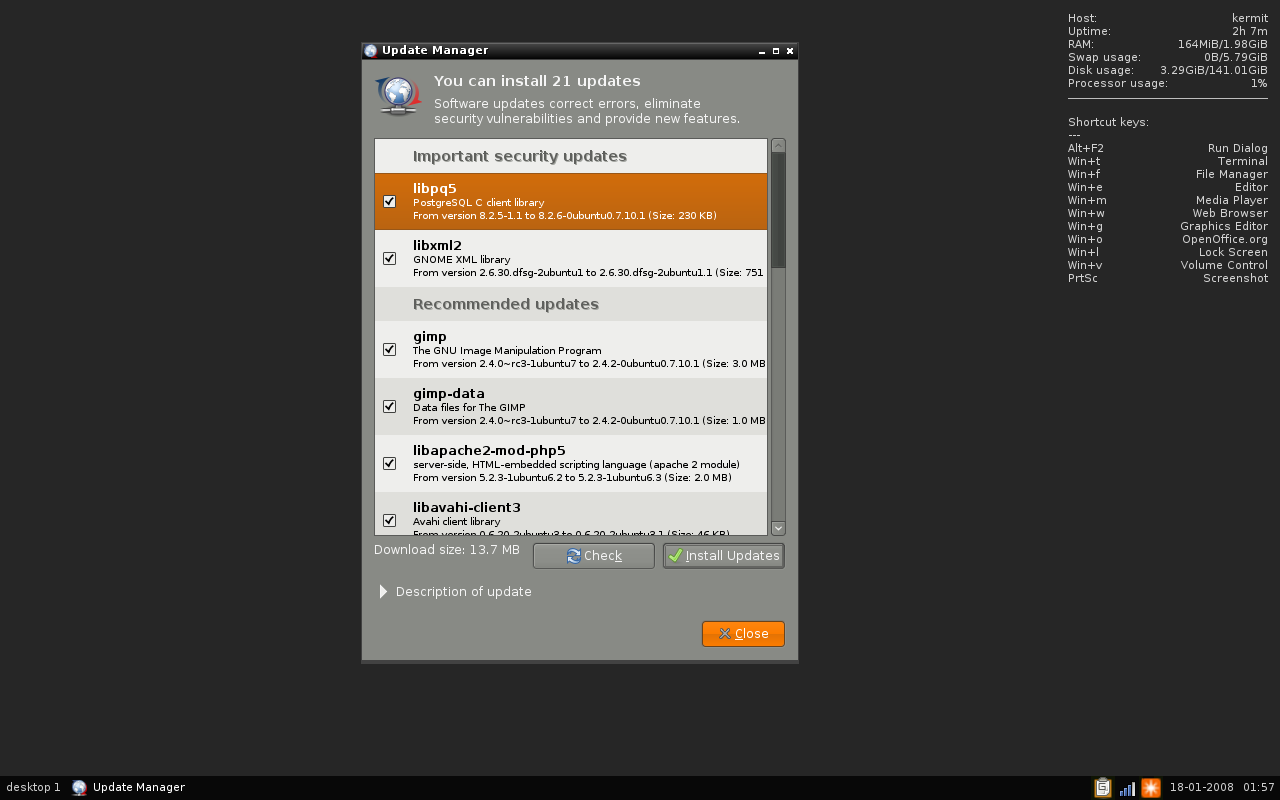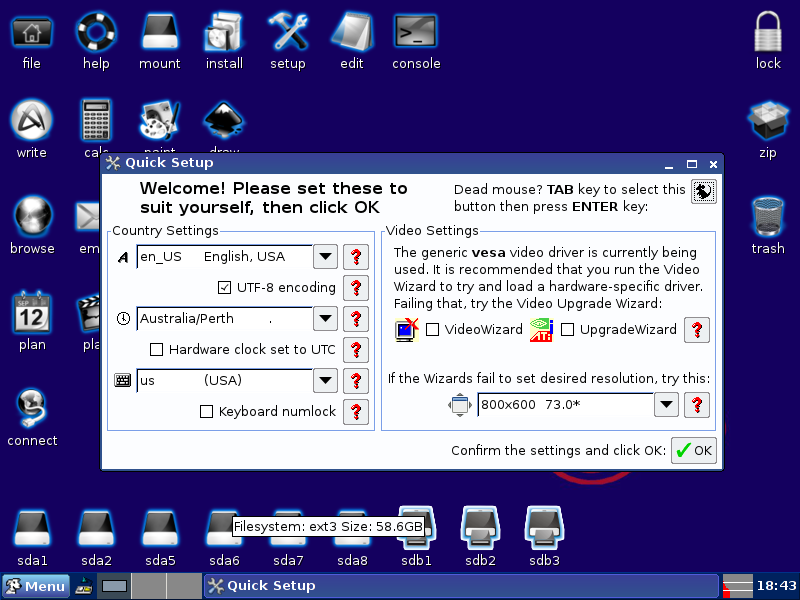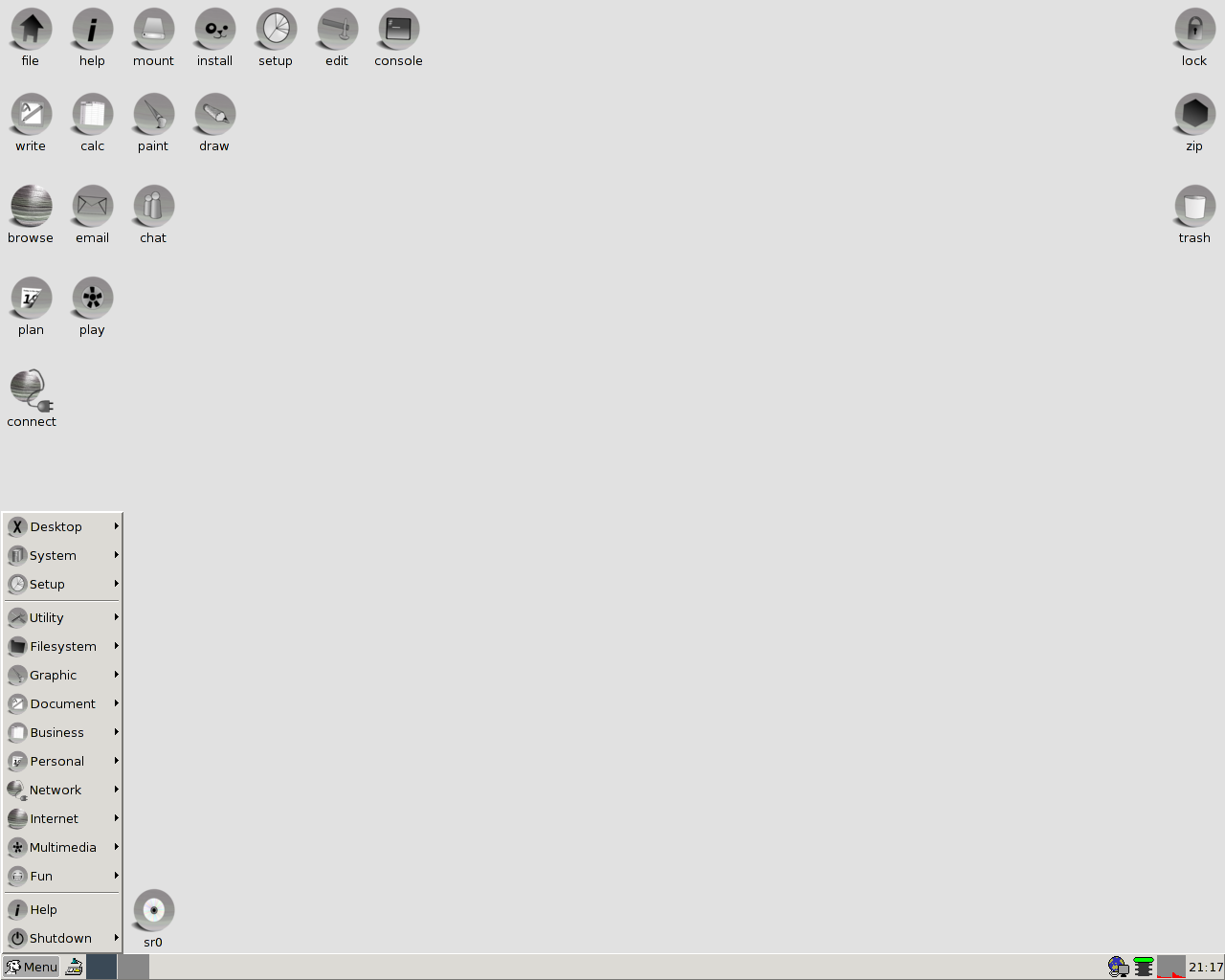Quirky Linux is an open source, fast, lightweight and featureful operating system based on the well known Puppy Linux distribution and designed from the ground up to be deployed on a wider range of computers and hardware platforms than the original Puppy Linux OS. It is created using the T2 build system.
Distributed as ISO, USFS and USB images
This custom Puppy Linux operating system is available for download as a Live CD ISO image, as well as XZ compressed USFS and USB images that must be extracted and deployed to USB flash drives of 8GB or higher capacity. It boots on both 32-bit and 64-bit computer platforms.
Very minimal boot menu à la Puppy Linux
The distribution uses the same minimalistic boot menu that is also found on the main Puppy Linux operating system, as well as several other Pupplets. Basically, it provides users with a boot prompt where they can hit Enter to start the live environment. However, you can press the F2 key on your keyboard to access a help menu.
Classic, traditional and fast desktop environment
The main attraction of any Puppy Linux operating system is the classic and traditional desktop environment, which is powered by JWM (Joe's Window Manager), a minimal and very fast window manager that looks cartoonish, yet very attractive. It uses a single panel layout from where the user can easily access the main menu, launch applications and interact with running programs.
Bottom line
Summing up, Quirky is one of those easy-to-use, lightweight and feature-rich operating systems that have been designed from the ground up to be deployed on low-end machines or computers with old and semi-old hardware components.
What is new in this release:
- Upgraded packages
- Improved handling of NTFS
- New applications JWMDesk, UrxvtControl, Take-a-shot
- New utilities aemenu-pango, replaceit, bcm
- Architectural fixes & improvements
- New multi-colour theme
- Revert overlay filesystem to aufs
- woofQ improvements
- Linux kernel 4.11.11, with aufs patch
- Mime handling for markdown, and new viewer, .tar.xz mime
- Network connection improved (SNS, PGPRS)
- SeaMonkey browser suite 2.48b1
- Xine multimedia player replaces VLC
What is new in version :
- Upgraded packages
- Improved handling of NTFS
- New applications JWMDesk, UrxvtControl, Take-a-shot
- New utilities aemenu-pango, replaceit, bcm
- Architectural fixes & improvements
- New multi-colour theme
- Revert overlay filesystem to aufs
- woofQ improvements
- Linux kernel 4.11.11, with aufs patch
- Mime handling for markdown, and new viewer, .tar.xz mime
- Network connection improved (SNS, PGPRS)
- SeaMonkey browser suite 2.48b1
- Xine multimedia player replaces VLC
What is new in version 8.1.6:
- System infrastructure and utilities improved and fixed
- Easyinit, a tiny ramdisk Quirky for f.s. check and recovery
- Linux kernel 4.4.40 1, SeaMonkey 2.46
- New "peachy-red" theme for GTK, JWM, icons and wallpaper
- Small download, yet has huge selection of packages
What is new in version 8.1:
- The old "April" series of Quirky is compiled totally from source packages, using T2. Quirky "Xerus" differs in that it is built with Ubuntu 16.04 Xenial Xerus binary DEBs.
- It must be emphasised that the mere fact of using Ubuntu DEBs does not make Quirky a clone of Ubuntu. Nothing could be further from the truth.
- Quirky Xerus behaves just like the April series, with the one difference that packages can be installed from the Ubuntu DEB repositories. The binary compatibility with Ubuntu offers a huge collection of packages, which is the main attraction of this series.
- However, some functionality of Ubuntu is castrated, such as systemd. These differences may mean that some Ubuntu DEBs may not work properly (but the vast majority should be fine).
- if anyone ever asks you "what type of desktop does Quirky run?", tell them "JWM and ROX-Filer". This has been the standard for Puppy and derivatives for the last ten years. JWM is a window manager that also runs the tray, ROX-Filer is a file manager on steroids, that also manages the desktop icons and background.
- Oh, and that systemd thing. No Puppy or derivative uses systemd. The standard for Puppy has always been the init mechanism provided by Busybox. You can find the guts of the bootup and shutdown scripts in /etc/rc.d. This works well, and is very fast -- the Pi3 boots to a fully-loaded desktop in about 9 seconds.
What is new in version 8.0:
- Quirky Linux 8.0 is released. This is codenamed "Xerus", as it has binary compatibility with Ubuntu 16.04 64-bit package repositories. This means that Quirky is able to install DEB packages from these repositories. Other than that, Quirky is in no way similar to Ubuntu!
- 8.0 has Linux kernel 4.4.7, SeaMonkey 2.40, and a host of applications to fill every need. As per inheritance from Puppy Linux, Quirky includes the "kitchen sink" in a very small download.
- Significant new features for 8.0, in no particular order, are BluePup GUI management for Bluetooth, the ISO now boots on UEFI-firmware machines, YASSM GUI to manage Samba
What is new in version 7.3:
- Quirky 7.3 is the start of the "Werewolf" series, able to install packages from the Ubuntu 15.10 Wily Werewolf repositories.
- Version 7.3 has major improvements to running from live-CD, with fast bootup, zram compression and session saving. The live-CD has become viable for on-going usage, as an alternative to performing an installation to fixed or removable drive. These improvements also apply to the "frugal" mode of installation.
- There have been numerous bug fixes and upgra
What is new in version 7.1:
- This is the latest release of Quirky Linux. The April series, that started at version 7.0, is built entirely from source using T2, and is not related in any way to any other distro.
- Appril 7.1 is a specialised build of the Quirky Linux April series, for Android app developers.
- These packages are included:
- Android SDK
- Android Studio
- App Inventor
- Oracle JDK
- LiveCode
- These packages and their dependencies have blown up this Quirky way beyond our usual pup. The download file is just under 1GB.
- The intention is to have out-of-the-box, just-click-and-get-going Android app development, catering for total non-programmers with App Inventor, through intermediate with LiveCode, to hard-core coders with Android Studio.
- A significant feature of Appril is that App Inventor runs locally, whereas the official project is hosted by MIT "in the cloud".
- A very significant difference from all other quirkies, puppies and Puppy-derivatives, is that Appril contains all development tools. Other pups are designed for users, with a optional humongous "devx" package available to provide all compiling, version control, etc.
- Appril has it all builtin, absolutely everything you can think of.
- This makes Appril superb as a compiling environment for any Linux project.
- The full Samba as well. You can see the package list in the running Appril, in files /root/.packages/woof-installed-packages and devx-only-installed-packages.
What is new in version 7.0:
- I created Puppy Linux back in 2003, but there was never a toolchain for compiling Puppy completely from source. Instead, Puppy is built from binary packages of another distro, plus PET packages compiled natively.
- We did use the T2 system right back at Puppy v2, T2 being a system to compile from source, however it only compiled a big chunk of the packages, not all. We still used manual compiling to create many PET packages.
- Until now. Starting in December 2014, I tackled the formidable task of compiling everything in T2, and I had to introduce 105 new packages into T2. It took a couple of months, but I eventually was able to compile every package required for Quirky (my fork of Puppy).
- T2 is able to compile for various CPU targets, and the proof of concept was when I compiled for a x86_64 CPU (all previous builds had been for i686). I was able to build a x86_64-based Quirky, and it works the same as the i686 build (after some tweaks).
- Great! I decided to jump this new Quirky to 7.0, and gave it the codename "April".
What is new in version 6.2:
- Bug fixes, upgrades and improvements
- Childproofing mechanism
- New popup utility "popup"
- FreeOffice (free version of SoftMaker Office)
- Linux kernel 3.16.6 (user: p#up#py password: l#in#ux)
What is new in version 6.1.2:
- There are quite a lot of fixes relative to 6.1.1, and upgrading is essential.
What is new in version 6.1.1:
- Quirky 6.1.1 has many important bug fixes, it is highly recommended to use.
What is new in version 6.1:
- Quirky 6.0 started the ball rolling with the feature set proposed for the 6.x series, now 6.1 adds the comprehensive upgrade, downgrade, rollback and recovery mechanisms. In essence, these are in three sections: rigorous handling of package uninstallation, such that the system can never be broken; system snapshots, with history, allowing recovery to any earlier state; simple version upgrade, with service packs.
What is new in version 6.0.1:
- Version 6.0.1 is a bug-fix release, however it has the first foundation-stone of the proposed "audit trail", that will allow easy upgrade, downgrade, recovery.
What is new in version 6.0:
- No Unionfs/Aufs (no layered filesystem).
- Deployed as a USB-stick/SD-card image only.
- Optimised for Flash, using f2fs.
- My own very simple replacement for udev. Using eudev, without rules
- No mesa, no llvm.
- Xorg has modesetting, vesa drivers only.
- No initrd.gz.
- No dbus.
- GTK 2.20.1.
- Run cupsd only when printing.
- Install and uninstall SFS files.
- Simplified version upgrade (and downgrade).
- Auditing, allowing rollback (system recovery).
- Child-proofing. Optional, make PC hard drives invisible.
What is new in version 1.4:
- The main purpose of releasing Quirky 1.4 is to test my experimental simplified module loading and interface configuration boot scripts (codename 'zzz').
- This is supposed to improve the detection and setup of sound, analog modems and 3G modems, and maybe more peripherals. Note, this complements the considerable earlier and ongoing development by Richard Erwin.
- 1.4 differs from 1.3 in that it is built from the Wary5 PET packages, of which the main feature is Xorg 7.3. Also an older kernel is used, 2.6.31.14 and the live-CD includes the complete collection of analog modem drivers as used in Wary, plus SCSI drivers. Thus, 1.4 will behave almost the same as Wary except for the 'zzz' component.
- There are some new features in Woof that are debuting here for testing. In particular, a "heavy duty" file downloader backend for the Puppy Package Manager and Video Upgrade Wizard (for now), which should fix any problems with downloading packages.
- Something new in Wary that has not yet been officially released, so is also being debuted in 1.4, is support for developing BaCon BASIC programs.
- Another thing inherited from Wary is the excellent multimedia support. For details on the applications in the as-yet-unreleased Wary, read my blog
What is new in version 1.3:
- ffmpeg supports webM 1
- Applications upgraded 1 2 3 4 5 6 7 8 9 10 11 12 13 14
- Application/utility bugfixes 1 2 3 4 5 6
- 2.6.30.5 kernel recompiled with patched Aufs, for Quirky-Retro 1 2
- Samba smaller, improved (also see Woof notes) 1 2 3 4
- Network disconnect/reconnect 1 2
- Thanks to 'stu90' for the great desktop image!
What is new in version 1.2:
- This continues bug fixing of 1.0/1.1, but also many packages are upgraded and new packages and ideas incorporated. In particular, a wider range of video/audio formats are supported, which is the main reason the live CD image file is a little bigger. There is now a very small HTML viewer for displaying local help files - this has basic CSS support. Release notes: many utilities and small applications upgraded; multimedia packages upgraded; many bug fixes; simple local-help HTML viewer with libgtkhtml. This release is supposed to play just about any audio/video file, DVD, embedded or streaming media, but not yet WebM/VP8 - I am targeting that for Quirky 1.3.
What is new in version 1.1:
- The main focus was to fix bugs in 1.0, but I also upgraded many applications. Most importantly, SeaMonkey has migrated from the 1.x series, after we solved some bugs with the 2.x series. JWM is now the default window manager and tray, as it is noticeably faster (and looks nicer) than Openbox/Fbpanel. Two showstoppers were Ayttm and You2pup did not work, both fixed.





Comments not found